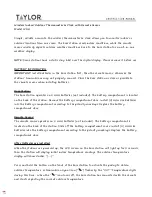
13
being controlled at a lower temperature, and saves energy.
The heating system will not work if a timeswitch or programmer has
switched it off.
The way to set and use your room thermostat is to fi nd the lowest
temperature setting that you are comfortable with, and then leave it
alone to do its job. The best way to do this is to set the room thermo-
stat to a low temperature – say 18°C – and then turn it up by one de-
gree each day until you are comfortable with the temperature. You
won’t have to adjust the thermostat further. Any adjustment above
this setting will waste energy and cost you more money.
If your heating system is a boiler with radiators, there will usually be
only one room thermostat to control the whole house. But you can
have different temperatures in individual rooms by installing ther-
mostatic radiator valves (TRVs) on individual radiators. If you don’t
have TRVs, you should choose a temperature that is reasonable for
the whole house. If you do have TRVs, you can choose a slightly high-
er setting to make sure that even the coldest room is comfortable,
then prevent any overheating in other rooms by adjusting the TRVs.
Room thermostats need a free fl ow of air to sense the temperature,
so they must not be covered by curtains or blocked by furniture.
Nearby electric fi res, televisions, wall or table lamps may prevent the
thermostat from working properly.
U
ser Instruc
tions
GB


































